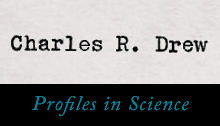Education
Higher Education Modules
Life after Death: Dr. Charles Drew, Civil Rights, and the Legacy of Race
About the Module
Author
Richard M. Mizelle, Jr. received his PhD in twentieth-century United States history and the history of medicine (2006) from Rutgers University. He teaches courses on the history of medicine, African American history, and historical intersections between race, environment, technology, and health at Florida State University. He is co-editor of Resilience and Opportunity: Lessons from the U.S. Gulf Coast after Katrina and Rita (Brookings Institution Press, 2011). His forthcoming book, Backwater Blues: The 1927 Mississippi Flood, Race, and Cultural Imaginations of Disaster (University of Minnesota Press, 2014), offers a critique of long-standing ideas of black environmental complacency by showing the ways in which black commentators from W.E.B. Du Bois to Bessie Smith provided an ecological intellectual criticism of the 1927 Mississippi River Flood. He is also currently finishing an article on the 2007 death of Deamonte Driver in a Washington, DC suburb from untreated tooth decay.
Suggested use
The Life after Death: Dr. Charles Drew, Civil Rights, and the Legacy of Race module is designed to introduce students to the rich avenues of intersection between the history of medicine/science and African American cultural history. Dr. Charles Drew's narrative is such that it cannot neatly fit into a single historical narrative but necessarily overlaps with questions of science and applicability, civil rights, race and segregation, and cultural memory. Therefore, this module is designed for scholars interested in connecting broad fields of historical analysis in the classroom. Instructors interested in the "Civil Rights Movement" might bring to bear questions of medicine/science in the classroom by highlighting the American Red Cross blood controversy and the response from traditional civil rights organizations like the NAACP. On the other hand, instructors teaching courses on "Medicine and Society" or the "History of Medicine" might frame important questions of race and health in lectures by demonstrating the ways in which science and medicine were far from "objective" when espousing contemporary societal ideas of human difference. For the latter, Dr. Drew's story can be particularly useful for students interested in medical careers or medical humanities.
The primary source materials and secondary readings serve as the foundation for spirited in-class discussions and research topics. Because Dr. Drew's narrative is so complicated, many of the secondary readings provide important context for students to better understand his life and death. As one example, the module provides source materials to help students comprehend why the policy of blood segregation was so offensive to Dr. Drew and civil rights organizations. This module is designed not only to engage students about the historical past, but also to challenge assumptions about the meaning and dissemination of knowledge. Instructors should be aware that parts of Dr. Drew's narrative can be particularly difficult for undergraduate students to grasp, particularly historical memory and rumors. Many students will suggest that if Dr. Drew was not mistreated by the medical establishment the story should end there. This module suggests that in some ways this is where the story begins. Laying a foundation of African American historical experiences as well as stressing the importance of rumors as history can help students understand this idea. Instructors should also anticipate this module will open far-reaching conversations about the meaning of race and blood. It has been my experience that students continue to have deeply held misconceptions about so-called racial differences that instructors should be prepared to address during class.
Objectives
At the conclusion of a unit or an entire module, students are expected to:
- Demonstrate an ability to critically analyze both primary and secondary sources.
- Describe how African American scientists like Dr. Charles Drew significantly shaped medicine and health during the 20th century.
- Explore the role of science/medicine during World War II and the Civil Rights Movement.
- Explain the ways in which Dr. Charles Drew's work standardizing the process of blood banking and the American Red Cross’s policy of segregation became an important battleground during the Modern Civil Rights Movement.
- Explore long-standing narratives of historical mistrust between African American communities and medical establishments.
- Draw on Dr. Charles Drew's historical narrative for understanding the importance of experiential truths as well as memory and rumors in the telling and re-telling of history.


